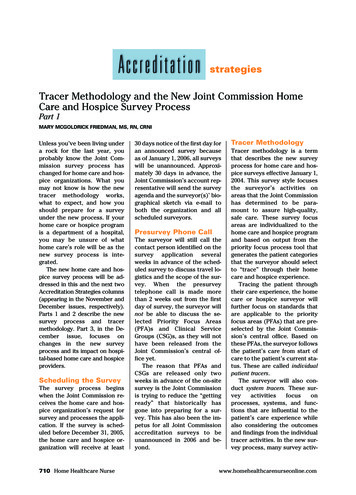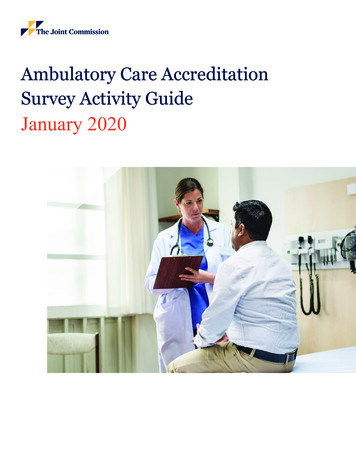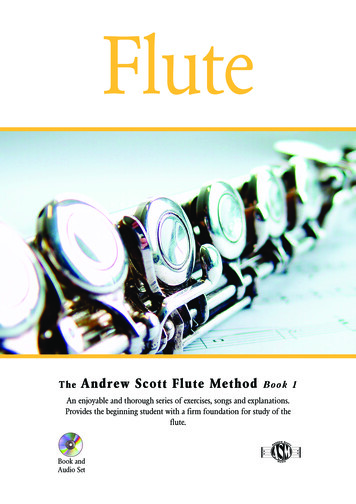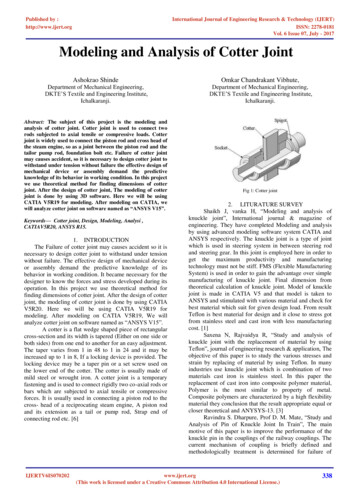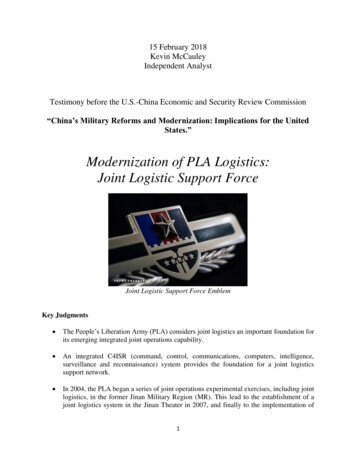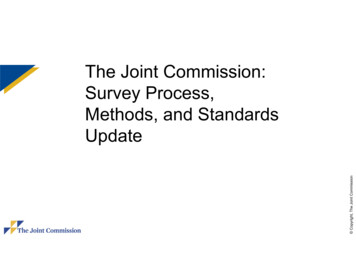
Transcription
Copyright, The Joint CommissionThe Joint Commission:Survey Process,Methods, and StandardsUpdate
Learning Objectives Discuss The Joint Commission mission & deemed statusUnderstand the survey processDescribe the SAFER MatrixUnderstand which standards are scored most frequently in2017Discuss the process of Standards creationUnderstand the new and revised EP’s in the LS and EC chapters We are NOT presenting a detailed EP discussion Copyright, The Joint Commission At the conclusion of this presentation, participants will be able to:
To continuously improve health care By evaluating health care organizations ‐meaningful assessment To provide safe and effective care Inspiring them to excel Copyright, The Joint CommissionMission:
The Joint Commission: Deemed Status HospitalsBehavior HospitalsHome Care, HospiceAmbulatory Healthcare, including Surgery CentersCritical Access HospitalsLabs Survey: Every 3 years (Labs: every 2 years) Copyright, The Joint Commission Deemed Programs:
TJC – Standards and Elements of Performance (EP’s) Tell us what you are going to do Tell us how you did it. Survey to 2012 editions of: NFPA 101 – Life Safety CodeNFPA 99 – Healthcare Facilities Code Approx. 700,000 / year Approx. 60,000 Deaths / year Copyright, The Joint Commission HAI
Copyright, The Joint Commission
The Joint CommissionField Director – Life SafetyCode Surveyors Copyright, The Joint CommissionJim Kendig,CHSP, CHCM, HEM,LHRM
The Joint CommissionField Director – Life SafetyCode Surveyors Copyright, The Joint CommissionTim Markijohn,MBA/MHA, CHFM,CHE
Life Safety Code Surveyors (LSCS)Field Director, LSCSTim Markijohn, MBA\MHA, CHFM, CHEField Director, LSCS78 Full/Part Time/Intermittent (hiring)Many currently work in healthcare facility managementMinimum of bachelors degree, most have multiple masters &doctorate levelLive across the country, survey the globeHigh performers, very engaged, top 1% Copyright, The Joint CommissionJim Kendig, MS, CHSP, CHCM, HEM, LHRM
Kenneth A. Monroe,PE, MBA, CHC, PMP Copyright, The Joint CommissionThe Joint CommissionDirector - Engineering
ACOAccreditation andCertification OperationsUnderstanding The Survey Process
Survey Types Full U (Full Unannounced\Triennial) Med Def (Medicare Deficiency) SSU/OQPS (Special Survey Unit & Office of Quality and Patient Safety) ICM 2 or 3 (Intracycle Monitoring) Extension Survey (New building/services) Copyright, The Joint Commission Medicare Survey (CLD on Initial)
Life Safety Code Surveyor Days ‐ 2018Hospitals – Each Physical Address Min. 2 LSCS days (new)Gross Building Square Footage2 LSCS Days3 LSCS DaysLSC FD ReviewNon Hospital Life Safety Code Surveyor Days - 2018Gross Building Square FootageAHC / ASC1 LSCS DayMed Def1 LSCS DaySSU / OQPS1 LSCS Day Copyright, The Joint Commission0 – 1,000,0001,000,000 – 1,500,000 1,500,000
The Hospital Survey Team Team Leader Physician or Nurse Life Safety Code Surveyor (LSCS) Other clinical team members Based on physical size of the organization and the amount and types of Copyright, The Joint Commissionprograms (HAP, OME, AHC, BHC)
SOC (BBI – Eapp) PFI’s not visible to LSCS Previous report and ESC’s Public web site Surveyor Resources Copyright, The Joint CommissionLSCS Pre Survey Review
Survey Agenda: LSCS Arrives with TeamDay 10800 0900Facility Orientation0800 0815Day #1 Morning Briefing0900 –0930OpeningConference/IntroductionsOnly0815 –1200Building Tour Cont’d0930 –1045ishDocument Review1200 –1230Lunch1230 –1430EC/EM Sessions (Separate)1430 –1530Enter day #2 Findings into report1530 –1600Interim LSCS Exit/Team Exit1045 –1200Pressure Relationships(OR’s/SPD)1200 –1230Lunch1230 –1600Building Tour(End of day Findings) Copyright, The Joint CommissionDay 2
Survey Agenda: Early Exit LSCS Pilot in 2016 & 2017 2018 and beyond Only 5 day surveys Changes to agenda For example – hard stop vs. morning briefing LSCS (or other surveyors such as BH, AHC) will not be on the last twodays Copyright, The Joint Commission Starting earlier
Day One morning: Facility OrientationMain Fire Panel - Upon arrival by the surveyor, an escort will be needed to take him/her to the main firealarm panel to verify that it is functional- check breaker. Copyright, The Joint CommissionTip for success: make sure you know location of electrical panel with the designated breaker forthe fire alarm.
Day One morning: Facility OrientationAreas Sprinklered (if not 100%)Fire BarriersSmoke BarriersSuites, including sizeSmoke CompartmentsChutes/shaftsApproved Equivalencies or Waivers Copyright, The Joint CommissionLife Safety Plans - The surveyor will then meet with an organization staff member(s) tobecome oriented to the layout of the building.
Day One morning: Facility OrientationNew May 2017 Visit generators Obtain name plate info, look for EPO Visit fire pump room Electric or diesel (Day tank at least 2/3 Full) Spare Sprinkler Heads and ToolsTip for success: Know the number and types of sprinklers so you candetermine the number of spares needed. Copyright, The Joint Commission Prior to the start of the building tour – the 3 Q’s
Day One morning: Document Review Paper or electronic, 90 minutes is the goal! Same checklist the Life Safety Code Surveyors (LSCS)/Hospital use Serves as Hospitals prep tool for survey – mock review Checklist has Standard, EP, Time frequencyTip for success: Organize testing document binder in same order as checklist Close all open issues and place work order right behind report Copyright, The Joint Commission Open book test
Day One morning: Document ReviewPolicies and procedures for Interim Life Safety Measures (ILSMs)Written fire response planEvaluations of fire drills conducted for the past 12 months – complete fire drillmatrixMaintenance records for fire protection & suppression equipmentMaintenance records for piped medical gas and vacuum systems Tip – LSCS will use IOU if not readily available Copyright, The Joint CommissionMaintenance records for emergency power systems
Copyright, The Joint CommissionDay One morning: Document List & Review Tool
Day One morning: Documentation Clarification Any document not available at time of survey cannot be clarified postsurvey Documents readily available Reduce the volume of post‐survey clarifications Copyright, The Joint Commission Less time and resources spent after the survey
Copyright, The Joint CommissionDay One morning: Fire Drill Matrix
Copyright, The Joint Commission
Fire Drills ‐ TipsTip for success: Reminder one drill per shift per quarter /‐ 10 days 1 hour between drills (Best Practice: Vary days) Number one location for fires in healthcare? Kitchen! Place central station and FDC checks on fire drill form – save time and Copyright, The Joint Commissionmoney and eliminate missed annual and quarterly requirements.
Day One morning: Pressure Relationships OR’s ‐ Positive to adjacent SPD ‐ Decontam ‐ Negative to adjacent SPD ‐ Prep/Pack, Sterilizing, Sterile storage – Positive to adjacent AIIR’s – Negative to corridor, .01” W.C.Tip for success: When you announce TJC in house – someone pleasecheck the critical pressure relationships Copyright, The Joint Commission Soiled Utility – Negative to Corridor
Day One afternoon: The Building Tour Roof – Lab exhausts (Not AIIR’s) Walk stair enclosures Mechanical Rooms, central plant (exit signs visible) Lab, Pharmacy, Kitchen Patients units Radiology, ED, Medical Records Fire/smoke Barriers Copyright, The Joint Commission Start at the top
Day One afternoon: The Building Tour FD’s (Label, Gap, Close, Latch, Plates) SD’s (Close, Gaps) Corridor doors, latching hardware, no more 5lb exception Above Ceiling (Sprinkler pipes, Barriers, J‐Boxes, Med Pipe) Entire building for EC, Hospital and Ambulatory for LS Copyright, The Joint CommissionTip for success: Above ceiling permit system in place?
Interim Life Safety Measures Policy Reviewed during document review, ILSM Reference guide given Mostly for LS findings, either corrected on site or not 8 hours Surveyor required to document in report what ILSM is put in place untilcorrected Copyright, The Joint CommissionTip for success: Know your ILSM policy – education can be limited tospecific staff such as plant ops and security
Copyright, The Joint CommissionILSM changes on the report
Copyright, The Joint CommissionILSM changes on the report
Ligature Update Start with Risk AssessmentRisk assessment CLD No Risk Assessment ITL Minor items not scored if appropriate risk assessment (such astoilet seat, shower curtain) Drop down boxes in WST similar to ILSM – pending Training of Security Officers who observe 1:1 Surveyor training 9/19/17 & continued dialogue with CMS andexpert panel – refer to Perspectives Copyright, The Joint Commission
Ligature Update Assure risk assessment conducted Action to implement plan Cite all ligature risks S&C Memo: 18‐06‐ Hospitals Guidance documents below See also 2014 FGI Guidelines EC.02.06.05 EP 1 Tip – who at your org is responsible for S&Cs? Copyright, The Joint Commission
Legionella Ref: S&C 17‐30‐Hospitals/CAHs/NHs June 02, 2017 Training September 22, 2017 Article in EC News – Sept 2017 – starting on page 6 Copyright, The Joint Commission EC.02.05.01
Copyright, The Joint CommissionSurvey Expectations
New Survey Report 2018 Removes white space Sorting feature Copyright, The Joint Commission Ability to see SLD vs. CLD
Perspective You are being evaluated on (HAP) 156 Eps – EC 193 Eps – LS 112 Eps – EM Keep things in ‘perspective!’ Copyright, The Joint Commission So using only EC and LS – you are being evaluated on 349 Eps .!
SAFER Matrix
Survey Analysis For Evaluating Risk (SAFER)MatrixImmediate Threat to Life(follows current ITL READ Copyright, The Joint CommissionLikelihood toHarmaPatient/Visitor/Staff
Survey Analysis for Evaluating Risk (SAFER) Matrix ‐Aggregate HOSPITAL Results for Entire 2017Likelihood toHarm aPatient/Staff/VisitorHIGHAll 1.54%EC 1.04%LS 0.21%All 1.65%EC 1.57%LS 0.23%All 1.56%EC 2.49%LS 0.13%MODERATEAll 16.53%EC 14.10%LS 7.87%All 12.88%EC 12.32%LS 5.78%All 4.37%EC 3.89%LS 1.10%LOWAll 42.05%EC 40.94%LS 65.72%All 15.17%EC 18.42%LS 16.83%All 3.87%EC 5.00%LS 2.14%LIMITEDPATTERNWIDESPREAD Copyright, The Joint CommissionImmediate Threat to LifeAll Standards 0.37%EC 0.22%LS 0.00%
Survey changes due to SAFER No more Direct and Indirect EP designations Consolidated ESC into one 60‐day timeframe No more A or C categories No more Opportunities for Improvement (OFIs) *No more Measures of Success (MOS)*Note: This does not apply to Sentinel Events where a MOS is required. At this time, the submittal of a MOS for Sentinel Events isstill required. Copyright, The Joint Commission See it / Cite it Survey Methodology
Copyright, The Joint CommissionFirst Half of 2017
Top 10 Findings:Most ChallengingStandardsEnvironment of Care (EC)andLife Safety (LS) ChaptersJanuary – December 2017
0962%59%49%29%51%30% Copyright, The Joint CommissionMost Cited Standards, 2017, 2016, 2015
Most Cited Standards, 2017 ‐ # 1Standard2017Rank% Non‐compliantLS.02.01.35159%4 Manage systems for extinguishing fires includingthe integrity (nothing supported by sprinklerpiping, missing escutcheons)41%5 Sprinkler heads are not damaged. They are freeof corrosion, foreign materials, paint, and havenecessary escutcheon plates installed34%14 Other issues, including: blocked access to fireextinguishersSummary Copyright, The Joint CommissionEP
Copyright, The Joint CommissionLS.02.01.35 – EP‐4 ‐ Sprinkler piping supports nothingelse.
Copyright, The Joint CommissionEC.02.06.01 – not considered ‘art’
Copyright, The Joint CommissionLS.02.01.35 – EP‐4 ‐ Sprinkler piping supports nothingelse.
Copyright, The Joint CommissionLS.02.01.35 – EP‐4 ‐ Sprinkler piping supports nothingelse.
Copyright, The Joint CommissionLS.02.01.35 – EP‐4 ‐ Sprinkler piping supports nothingelse.
Standard2017Rank% Non‐compliantEPSummaryEC.02.05.01245%8Labels utility system controls to facilitate partialor complete emergency shutdowns40%15 In critical areas the organization manages riskassociated with Utility Systems, includingPressure relationships, Filtration, Air Exchanges(ach), and Temperature and Humidity25%16 In non‐critical areas the organization managesrisk associated with Utility Systems, includingPressure relationships, Temperature andHumidity Copyright, The Joint CommissionMost Cited Standards ‐ # 2
Copyright, The Joint CommissionEC.02.05.01 EP15 Critical Pressure Relationships
Most Cited Standards, 2017 ‐ # 4Standard2017Rank% Non‐compliantLS.02.01.30438%3 Building and fire protection features: ExistingHazardous Areas32%18 Smoke Barrier integrity30%11 Corridor doors20%19 Smoke barrier doorsSummary Copyright, The Joint CommissionEP
Copyright, The Joint CommissionLS.02.01.30
Most Cited Standards, 2017 ‐ # 5 & # 6Standard2017Rank% Non‐compliantEPEC.02.06.01566%113%26 Furniture and equipment39%738%10 Building and fire protection generalrequirements: Barrier Penetrations6Safe environment, including ligature risks,stained ceiling tiles, mismanaged pull cordsBuilding and fire protection generalrequirements: Fire‐rated door Copyright, The Joint CommissionLS.02.01.10Summary
Copyright, The Joint CommissionLS.02.01.10 – EP‐14 – Barrier Penetrations
Copyright, The Joint CommissionLS.02.01.10 – EP‐14 – Barrier Penetrations
Copyright, The Joint CommissionLS.02.01.10 – EP‐14 – Barrier Penetrations
Copyright, The Joint CommissionLS.02.01.10 EP 7, now EP 11 Rated Door
Copyright, The Joint CommissionLS.02.01.10 EP 7, now EP 11 Undercuts Rated Door:( 3/4”)
Most Cited Standards, 2017 ‐ # 7 & # 82017RankEC.02.02.017EC.02.05.058% Non‐ EPcompliantSummary42%5 Minimize risks with hazardous chemicals26%12 Hazardous materials and waste labeling52%6 ITM of non‐high risk utility equipment12%5 ITM of infection control utility equipment Copyright, The Joint CommissionStandard
Most Cited Standards, 2017 ‐ # 9 & # 10Standard2017Rank% Non‐compliantLS.02.01.20932%11 Means of egress clear and unobstructed18%1Locking arrangements37%6Medical gas cylinder management25%5Medical gas shut off valves labeled and accessible10Summary Copyright, The Joint CommissionEC.02.05.09EP
Copyright, The Joint CommissionLS.02.01.20 EP 11 Corridor Clutter
Copyright, The Joint CommissionLS.02.01.20 EP Stairwell Storage
Copyright, The Joint CommissionEC.02.05.06 Med Gas Storage
Copyright, The Joint CommissionEM Update
New EM StandardsHere is the count for deemed programs: 32 ‐ OME/Hospice 22 ‐ OME/Home Health Agencies 26 ‐ AHC/Ambulatory Surgical Centers 9 ‐ HAP 8 ‐ CAH Copyright, The Joint Commission
January 2018 RevisedElements of PerformanceModificationsAlignment with CMS K-tagsBased on NFPA 101-2012 and NFPA99-2012
Copyright, The Joint CommissionTimeline for Creation EPs
How Many EPs were touchedNEWMOVED REVISED REVISED DELETED& MOVEDEC29312280LS498615394TOTALS7811737474TOTAL EP'sTouched283 Copyright, The Joint CommissionChapter
LS.02.01.30 EP‐12 (was EP‐11) In new buildings, all corridor doors are constructed toresist the passage of smoke, . Positive latching hardware is required. Roller latchesare prohibited. NFPA 101-2012: 18.3.6.3.1; 18.3.6.3.5; 18.3.6.4; Copyright, The Joint Commission18.3.6.5; 18.3.6.3.10; 18.3.6.3.11)
LS.02.01.30 EP‐13 (was EP‐12) r – 1/13/17smoke and . (No Change) Note 1: For hospitals that use Joint Commission accreditation for deemed statuspurposes: Powered corridor doors are equipped with positive latching hardwareunless the organization can verify that this equipment is not an option provided by thedoor manufacturer. In instances where positive latching hardware is not an availableoption provided by the manufacturer, the device used must be capable of keeping thedoor fully closed when a force of 5 pounds is applied at the latch edge and in anydirection to a sliding or folding door, whether or not power is applied in accordancewith NFPA 101‐2012: 19.3.6.3.7. (continued ) Copyright, The Joint Commission In existing buildings, all corridor doors are constructed to resist the passage of
LS.02.01.30 EP‐13 (was EP‐12) r –1/13/17page 2 Note 2: For hospitals that use Joint Commission accreditation for deemed Copyright, The Joint Commissionstatus purposes: Doors to toilet rooms, bathrooms, shower rooms, sinkclosets, and similar auxiliary spaces (except pantries) that do not containflammable or combustible materials are not required to have a devicecapable of keeping the door fully closed if a force of 5 pounds is applied atthe latch edge. In these cases, roller latches on these doors that keep adoor closed when a force of 5 pounds is applied are permissible.
Physical Environment as a Priority The needs of the organization cannot be met if the physicalenvironment fails Facilities staff must understand the current physical environment Facilities must partner with Leadership in managing theinfrastructure Copyright, The Joint Commissionrequirements, which may be difficult to achieve with the currentbuilding technologies
Statement of Conditions Update
Statement of Conditions - Terms BBI: Basic Building Information PFI: Plan For Improvement Extensions SPFI: Survey‐Related Plan For Improvement TLW: Time Limited Waiver Equivalency: Traditional or FSES (Fire Safety Evaluation System) Ligature Facility Extension Request (LFER) Copyright, The Joint Commission Sites are populated by eApp (electronic application)
Statement of Conditions All RFIs effective January 1, 2017 will have a 60 day ESC from the last day ofsurvey. If a National Fire Protection Association (NFPA) Code, physical environment If the organization is planning on submitting an Equivalency, the SPFI and TLW may besubmitted prior to the submission of the Equivalency. The organization’s SPFI and TLWrequest should consider the time to develop and approve an equivalency. Once the Joint Commission approves an equivalency it will be documented in theorganization’s History/Audit Trail and then sent to CMS for approval (if applicable). Copyright, The Joint Commissiondeficiency that is scored under EC or LS cannot be resolved within the 60 dayESC, no later than 30 days from the last day of survey the organization mustsubmit for a SPFI and a TLW.
Statement of Conditions The organization does not need to have an approved SPFI or TLW for the ESCsubmission. They just need to be submitted. Follow‐up surveys need to either show:2.3.The RFI has been correctedEvidence that the RFI will be completed within the 60 day ESC(work order, invoice, etc.)A submitted SPFI and TLW TLWs and Equivalencies are only sent to CMS for deemed status HCOs Copyright, The Joint Commission1.
Time Limited Waiver (TLW) A Time Limited Waiver is a process to provide additional time to complete LifeSafety Chapter corrective actions Organizations that use Joint Commission accreditation for deemed status Create a Survey‐related Plan For Improvement (SPFI) Enter the requested date in the Scheduled Completion Date field When prompted, complete the Time Limited Waiver form Submit to the Joint Commission The Joint Commission will review and forward the request to the Regional Officefor final decision Non‐deemed organizations: process same, stops at TJC Copyright, The Joint Commissionpurposes are to follow this process:
CMS & Equivalencies Organizations that use Joint Commission accreditation for deemed status The Engineering staff will work with the organizations until the requestis acceptable by both TJC and CMS RO CMS requires that an existing equivalency be recited and resubmitted atthe triennial survey.August 2016 Perspectives Copyright, The Joint Commissionpurposes: Survey‐related equivalencies will continue to be submitted to ouroffices
Ligature Facility Extension Request (LEFR) Ligature / Self‐Harm Risks that result with a Condition Level forDeemed Status organizations will receive a Medicare DeficiencyFollow‐up Survey (CLD01 – MedDef) If not cleared at time of MedDef a Secondary MedDef will be Removed (permanent solution) Replaced Risk Assessed and Mitigated – where permitted only Non‐deemed may result in a Accreditation with Follow‐up Survey(AFS) Copyright, The Joint Commissionscheduled (AFS08)
PHASE 2 – COMING SUMMER 2018Phase 2 will be used for Deemed and Non-DeemedOrganizations Copyright, The Joint CommissionLigature Facility Extension Request - Introducing
Ligature Facility Extension Request Submitted to SIG‐Clinical and Engineering for review and approval If rejected, a conference call will be coordinated to determine an acceptablePlan of Correction/Mitigation Evidence of Standards Compliance (ESC) will be accepted based on a Joint Copyright, The Joint CommissionCommission “Recommended for Approval” LFER for Deemed and a Joint CommissionAccepted SPFI/TLW for Non‐Deemed.
Ligature Facility Extension Request Deemed: Approximately 1 week prior to the Secondary MedDef theAccount Executive will contact the HCO to determine is all ligature /self‐harm deficiencies will be resolved. Yes – Secondary MedDef will occur If additional findings or deficiencies are not cleared, MedDefprocess will start over (CLD01)No – Secondary MedDef Postponed (Validation Survey) Account Executive will provide the HCO: Attestation Letter: acknowledging that they need additionaltime to resolve ligature / self‐harm deficiencies Due immediately Copyright, The Joint Commission
Other pending projects BBI V2.0 More specific and useable information Copyright, The Joint Commission Re‐build of EC SAG
Tools & Resources
Copyright, The Joint CommissionJoint Commission Physical Environnent Portal
Copyright, The Joint CommissionThe Joint Commission Connect Extranet Site
Copyright, The Joint Commissionwww.jointcommission.org/safer
Copyright, The Joint CommissionReview and ConclusionITL
Questions?Jim Kendig, MS, CHSP, CHCM, HEM, LHRMField Directorjkendig@jointcommission.org(630) 792-5819Field Directortmarkijohn@jointcommission.org(630) 792-5148Kenneth A. Monroe, PE, MBA, CHC, PMPDirector - Engineeringkmonroe@jointcommission.org(630) 792-5758 Copyright, The Joint CommissionTim Markijohn, MBA\MHA, CHFM, CHE
The Joint Commission Disclaimer These slides are current as of 04/3/2018. The Joint Commission and the original presenters reserve the right tochange the content of the information, as appropriate. These will only be available until 04/3/2019. At that point The Joint Commission reserves the right to review andretire content that is not current, has been made redundant, or has technical issues. These slides are only meant to be cue points, which were expounded upon verbally by the original presenter and arenot meant to be comprehensive statements of standards interpretation or represent all the content of thepresentation. Thus, care should be exercised in interpreting Joint Commission requirements based solely on thecontent of these slides. These slides are copyrighted and may not be further used, shared or distributed without permission of the original Copyright, The Joint Commissionpresenter and The Joint Commission.
January 2018 Revised Elements of Performance Modifications Alignment with CMS K-tags Based on NFPA 101-2012 and NFPA 99-2012


